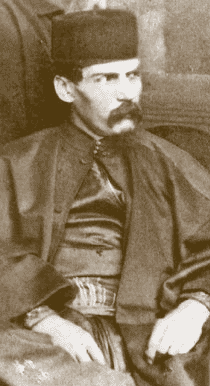
One of the most odious acts for a non-Muslim to do is enter Mecca. The swash-buckling Captain Richard Burton (1821-1890) disguised himself as an Afghan (pre-Taliban, of course) Muslim and in 1853 joined pilgrims to Mecca. While not the first Westerner to sneak into the holy city, his account is the most notorious. Here is how Burton describes his participation:
“”Alhamdu Lillah!” Thanks be to God! we were now at length to gaze upon the Kiblah, to which every Mussulman has turned in prayer since before the days of Muhammed, and which, for long ages before the birth of Christianity was reverenced by the Patriarchs of the East. Soon after dawn arose from our midst the shout of ‘Labbaik! Labbaik!’ and passing between the rocks, we found ourselves in the main street of Mecca, and approached the ‘Gateway of Salvation,’ one of the thirty-nine portals of the ‘Temple of Salvation.’
On crossing the threshold we entered a vast unroofed quadrangle, a mighty amplification of the Palais Royal, having on each side of its four sides a broad colonnade, divided into three aisles by a multitude of slender columns, and rising to the height of about thirty feet. Surmounting each arch of the colonnade is a small dome: in all there are a hundred and twenty, and at different points arise seven minarets, dating from various epochs, and of somewhat varying altitudes and architecture. The numerous pigeons which have their home within the temple have been believed never to alight upon any portion of its roof, thus miraculously testifying to the holiness of the building. This marvel, however, of late years having been suspended, many discern another omen of the approach of the long-predicted period when unbelievers shall desecrate the hallowed soil.
In the center of the square area rises the far-famed Kabah, the funereal shade of which contrasts vividly with the sunlit walls and precipices of the town. It is a cubical structure of massive stone, the upper two-thirds of which are mantled by a black cloth embroidered with silver, and the lower portion hung with white linen. At a distance of several yards it is surrounded by a balustrade provided with lamps, which are lighted in the evening, and the space thus enclosed is the circuit ground along which, day and night, crowds of pilgrims, performing the circular ceremony of Tawaf, realize the idea of perpetual motion. We at once advanced to the black stone embedded in the angle of the Kabah, kissed it, and exclaimed ‘Bismillah wa Allahu Akbar,’ — ‘In God’s name, and God is Greatest.’ Then we commenced the usual seven rounds, three at a walking pace, and four at a brisk trot. Next followed two prayer-flections at the tomb of Abraham, after which we drank of the water of Zamzam, said to be the same which quenched the thirst of Hagar’s exhausted son.
Besides the Kabah, eight minor structures adorn the quadrangle, the well of Zamzam, the library, the clockroom, the triangular staircase, and four ornamental resting-places for the orthodox sects of Hanafi, Shafi, Maliki, and Hanbali.
We terminated our morning duties by walking and running seven times along the streets of Safa and Marwa, so named from the flight of seven steps at each of its extremities. After a few days spent in visiting various places of interest, such as the slave-market and forts, and the houses of the Prophet and the Caliphs Ali and Abu bakr, we started on our six hours’ journey to the mountain of Arifat, an hour’s sojourn at which, even in a state of insensibility, confers the rank of haji. It is a mountain spur of about a hundred and fifty feet in height, presenting an artificial appearance from the wall encircling it and the terrace on its slope, from which the imam delivers a sermon before the departure of his congregation for Mecca. His auditors were, indeed, numerous, their tents being scattered over two or three miles of the country. A great number of their inmates were fellow-subjects of ours from India [Burton posed as a native Afghan]. I surprised some of my Mecca friends by informing them that Queen Victoria numbers among twenty millions of Mohammedans among her subjects.
On the 5th of June, [1853] at sunset, commencing our return, we slept at the village of Muzdalifah, and there gathered and washed seven pebbles of the size of peas, to be flung at three piles of whitewashed masonry known as the Satans of Muna. We acquitted ourselves satisfactorily of this duty on the festival of the 6th of June, the 10th day of the Arabian month Zu’lhijah. Each of us then sacrificed a sheep, had his hair and nails cut, exchanged the ikram for his best apparel, and embracing his friends, paid them the compliments of the season. The two following days the Great, the Middle, and the Little Satan were again pelted, and, bequeathing to the unfortunate inhabitants of Muna the unburied and odorous remains of nearly a hundred thousand animals, we returned, eighty thousand strong, to Mecca. A week later, having helped to insult the tumulus of stones which marks, according to popular belief, the burial place of Abulahab, the unbeliever, who we learn from the Koran, has descended into hell with his wife, gatherer of sticks, I was not sorry to relinquish a shade temperature of 120 degrees and wend my way to Jeddah en route for England, after delegating to my brethren the recital of a prayer in my behalf at the Tomb of the Prophet in Medina.â€
Excerpts from Richard Burton, Personal Narrative of a Pilgrimage to Al Madinah and Mecca, London, Longman, Brown, Green, and Longmans, 1855.